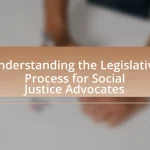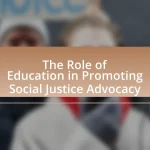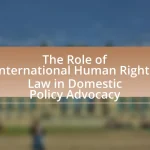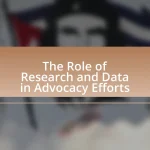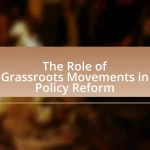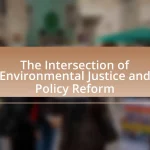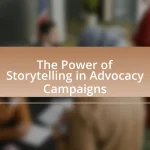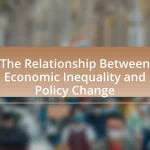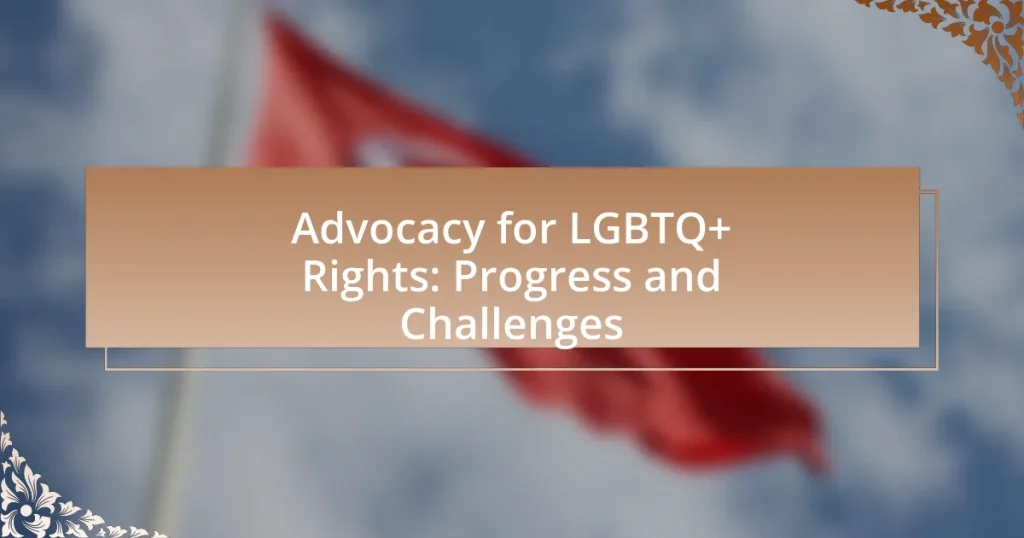Advocacy for LGBTQ+ rights encompasses organized efforts to promote and protect the civil rights, social acceptance, and legal recognition of individuals identifying as lesbian, gay, bisexual, transgender, queer, and other sexual and gender minorities. The article examines the importance of advocacy in driving social change, highlights historical milestones such as the Stonewall Riots and the Obergefell v. Hodges ruling, and discusses the varying goals of LGBTQ+ advocacy across different regions. It also addresses the impact of cultural attitudes, representation in media, and ongoing challenges such as discrimination and violence, while emphasizing the role of organizations and grassroots movements in achieving equality. Finally, the article outlines strategies for overcoming barriers and the significance of education in promoting LGBTQ+ rights.

What is Advocacy for LGBTQ+ Rights?
Advocacy for LGBTQ+ rights is the organized effort to promote and protect the civil rights, social acceptance, and legal recognition of individuals who identify as lesbian, gay, bisexual, transgender, queer, or other sexual and gender minorities. This advocacy seeks to address discrimination, violence, and inequality faced by LGBTQ+ individuals, aiming for equal treatment under the law and societal acceptance. Historical milestones, such as the decriminalization of homosexuality in various countries and the legalization of same-sex marriage in numerous jurisdictions, demonstrate the impact of advocacy efforts. For instance, the U.S. Supreme Court’s decision in Obergefell v. Hodges (2015) legalized same-sex marriage nationwide, showcasing the effectiveness of sustained advocacy campaigns.
Why is advocacy important for LGBTQ+ rights?
Advocacy is crucial for LGBTQ+ rights because it drives social change and legal protections for marginalized communities. Through advocacy, individuals and organizations raise awareness about discrimination, promote equality, and influence policy decisions that affect LGBTQ+ individuals. For instance, advocacy efforts have led to significant legal advancements, such as the legalization of same-sex marriage in numerous countries, including the United States in 2015, which was a result of sustained advocacy campaigns. Additionally, advocacy helps to combat stigma and violence against LGBTQ+ individuals, as evidenced by the increase in hate crime reporting and the push for comprehensive anti-discrimination laws. Thus, advocacy serves as a vital mechanism for achieving and maintaining rights and protections for LGBTQ+ individuals.
What historical events have shaped LGBTQ+ advocacy?
Key historical events that have shaped LGBTQ+ advocacy include the Stonewall Riots of 1969, which marked a pivotal moment in the fight for LGBTQ+ rights in the United States. The riots were a response to a police raid at the Stonewall Inn in New York City, leading to increased visibility and activism within the LGBTQ+ community. Following this, the formation of organizations such as the Gay Liberation Front and the Human Rights Campaign in the 1970s and 1980s further solidified advocacy efforts. Additionally, the AIDS crisis in the 1980s galvanized activism, leading to the establishment of groups like ACT UP, which fought for medical research and treatment access. Landmark legal decisions, such as the U.S. Supreme Court’s ruling in Obergefell v. Hodges in 2015, which legalized same-sex marriage nationwide, also significantly advanced LGBTQ+ rights. These events collectively illustrate the evolution and milestones of LGBTQ+ advocacy over the decades.
How do cultural attitudes influence LGBTQ+ advocacy?
Cultural attitudes significantly influence LGBTQ+ advocacy by shaping public perception and acceptance of LGBTQ+ individuals. Positive cultural attitudes can lead to increased support for LGBTQ+ rights, resulting in legislative changes and social acceptance, as seen in countries like Canada and the Netherlands, where progressive cultural norms have facilitated the legalization of same-sex marriage and anti-discrimination laws. Conversely, negative cultural attitudes can hinder advocacy efforts, creating environments where discrimination and violence against LGBTQ+ individuals are prevalent, as evidenced in regions with strong anti-LGBTQ+ sentiments, such as parts of Eastern Europe and Africa, where advocacy faces severe backlash and legal challenges.
What are the key goals of LGBTQ+ advocacy?
The key goals of LGBTQ+ advocacy include achieving equal rights, combating discrimination, and promoting social acceptance for LGBTQ+ individuals. Advocacy efforts aim to secure legal protections against discrimination in areas such as employment, housing, and healthcare, as evidenced by the passage of laws like the Equality Act in the United States, which seeks to extend civil rights protections to LGBTQ+ individuals. Additionally, LGBTQ+ advocacy focuses on raising awareness about issues such as mental health, violence, and stigma faced by the community, supported by studies indicating higher rates of mental health challenges among LGBTQ+ individuals due to societal discrimination.
How do these goals vary across different regions?
LGBTQ+ rights advocacy goals vary significantly across different regions due to cultural, legal, and social factors. In Western countries, such as Canada and many European nations, the focus is often on achieving marriage equality, anti-discrimination laws, and comprehensive healthcare access for LGBTQ+ individuals. In contrast, in regions like the Middle East and parts of Africa, the primary goals may include decriminalization of homosexuality and basic human rights protections, as many countries still impose severe penalties for same-sex relationships. For instance, a 2021 report by ILGA World indicated that 69 countries still criminalize same-sex relationships, highlighting the urgent need for advocacy in those regions. Thus, the specific goals of LGBTQ+ rights advocacy are shaped by the prevailing legal frameworks and societal attitudes in each region.
What role do organizations play in achieving these goals?
Organizations play a crucial role in achieving LGBTQ+ rights goals by advocating for policy changes, raising awareness, and providing support services. They mobilize resources and communities to influence legislation, such as the legalization of same-sex marriage in various countries, which was significantly driven by advocacy groups like the Human Rights Campaign. Additionally, organizations conduct research and disseminate information to educate the public and combat discrimination, as evidenced by studies showing that increased visibility and representation lead to greater acceptance of LGBTQ+ individuals. Through these efforts, organizations not only promote equality but also foster a supportive environment for LGBTQ+ individuals, contributing to societal progress.

What progress has been made in LGBTQ+ rights advocacy?
Significant progress has been made in LGBTQ+ rights advocacy, particularly in legal recognition and societal acceptance. For instance, as of 2023, over 30 countries have legalized same-sex marriage, including the United States, Canada, and many European nations, reflecting a shift towards greater equality. Additionally, numerous countries have enacted anti-discrimination laws protecting LGBTQ+ individuals in areas such as employment and housing, with the European Union mandating such protections for its member states. Furthermore, public opinion polls indicate increasing support for LGBTQ+ rights, with a 2021 Gallup poll showing that 70% of Americans support same-sex marriage, up from just 27% in 1996. These advancements demonstrate a notable transformation in both legal frameworks and societal attitudes towards LGBTQ+ individuals.
What significant legal milestones have been achieved?
Significant legal milestones achieved in the advocacy for LGBTQ+ rights include the legalization of same-sex marriage in numerous countries, notably the United States with the Supreme Court ruling in Obergefell v. Hodges in 2015, which affirmed the constitutional right to marry for same-sex couples. Additionally, the repeal of “Don’t Ask, Don’t Tell” in 2011 allowed LGBTQ+ individuals to serve openly in the U.S. military. Furthermore, the recognition of LGBTQ+ rights in anti-discrimination laws has progressed, with various states and countries enacting protections against discrimination based on sexual orientation and gender identity. These milestones reflect a broader societal shift towards equality and acceptance, supported by legal frameworks that protect LGBTQ+ individuals’ rights.
How have these milestones impacted LGBTQ+ communities?
Milestones in LGBTQ+ rights advocacy have significantly advanced the visibility, acceptance, and legal protections for LGBTQ+ communities. For instance, the legalization of same-sex marriage in numerous countries has not only granted legal recognition to same-sex couples but has also fostered greater societal acceptance, as evidenced by a 2019 Gallup poll indicating that 70% of Americans support same-sex marriage, up from 27% in 1996. Additionally, the repeal of discriminatory laws, such as the Defense of Marriage Act in the United States, has led to increased access to healthcare, adoption rights, and anti-discrimination protections, thereby improving the overall quality of life for LGBTQ+ individuals. These milestones have collectively contributed to a more inclusive society, reducing stigma and promoting equality.
What role has public opinion played in these legal changes?
Public opinion has significantly influenced legal changes regarding LGBTQ+ rights by shaping political agendas and prompting legislative action. For instance, as societal acceptance of LGBTQ+ individuals increased, evidenced by a 2019 Gallup poll showing 70% of Americans supporting same-sex marriage, lawmakers responded by enacting laws that reflect this shift in public sentiment. This correlation between public opinion and legal reform is further illustrated by the rapid legalization of same-sex marriage across various states following widespread advocacy and changing attitudes, demonstrating that when public support is strong, it can lead to substantial legal advancements.
How has representation in media influenced LGBTQ+ rights?
Representation in media has significantly influenced LGBTQ+ rights by shaping public perceptions and fostering acceptance. Positive portrayals of LGBTQ+ individuals in television, film, and literature have contributed to increased visibility and understanding, which in turn has led to greater advocacy for equal rights. For instance, the portrayal of LGBTQ+ characters in mainstream media, such as the television series “Will & Grace,” has been credited with helping to normalize LGBTQ+ identities and experiences, leading to shifts in societal attitudes. Research from the Williams Institute indicates that increased representation correlates with higher levels of support for LGBTQ+ rights, demonstrating that media representation plays a crucial role in advancing social change and legislative progress for the LGBTQ+ community.
What are some examples of positive representation?
Positive representation of LGBTQ+ individuals includes diverse portrayals in media, such as the character of David Rose in “Schitt’s Creek,” who is depicted as a successful, loving, and multifaceted individual. Another example is the inclusion of LGBTQ+ characters in children’s programming, like the animated series “Steven Universe,” which features a range of relationships and identities, promoting acceptance and understanding from a young age. Additionally, the visibility of LGBTQ+ athletes, such as Megan Rapinoe, who openly advocates for equality and representation in sports, further enhances positive representation by challenging stereotypes and inspiring others. These examples demonstrate how positive representation can foster inclusivity and acceptance within society.
How does representation affect societal attitudes towards LGBTQ+ individuals?
Representation significantly influences societal attitudes towards LGBTQ+ individuals by fostering visibility and normalizing diverse identities. When LGBTQ+ individuals are portrayed positively in media, literature, and public life, it challenges stereotypes and reduces stigma, leading to greater acceptance. Research indicates that exposure to LGBTQ+ characters in popular media correlates with increased empathy and understanding among viewers. For instance, a study published in the Journal of Homosexuality found that individuals who consumed LGBTQ+-inclusive media reported more favorable attitudes towards LGBTQ+ people. This demonstrates that representation not only reflects societal changes but actively shapes them, promoting inclusivity and reducing discrimination.

What challenges remain in the fight for LGBTQ+ rights?
Significant challenges remain in the fight for LGBTQ+ rights, including discrimination, lack of legal protections, and social stigma. Discrimination persists in various sectors such as employment, housing, and healthcare, where LGBTQ+ individuals often face unequal treatment. For instance, a 2021 report by the Human Rights Campaign indicated that 46% of LGBTQ+ workers experienced discrimination in the workplace. Additionally, many countries lack comprehensive legal protections against hate crimes targeting LGBTQ+ individuals, contributing to a climate of fear and violence. Social stigma continues to hinder acceptance, with surveys showing that a substantial portion of the population still holds negative views towards LGBTQ+ people, impacting their mental health and well-being. These ongoing issues highlight the need for continued advocacy and policy reform to ensure equal rights and protections for the LGBTQ+ community.
What are the ongoing legal and political challenges?
Ongoing legal and political challenges for LGBTQ+ rights include discriminatory laws, lack of comprehensive anti-discrimination protections, and political opposition to equality measures. For instance, in several U.S. states, legislation has been introduced that restricts transgender individuals’ access to healthcare and participation in sports, undermining their rights. Additionally, many countries still have laws criminalizing same-sex relationships, which perpetuates stigma and violence against LGBTQ+ individuals. These challenges are compounded by political rhetoric that often frames LGBTQ+ rights as controversial, leading to further marginalization and resistance to progress.
How do discrimination and violence against LGBTQ+ individuals persist?
Discrimination and violence against LGBTQ+ individuals persist due to systemic societal biases, lack of legal protections, and cultural stigmas. These factors create an environment where hate crimes and discrimination are more likely to occur; for instance, the FBI reported that in 2020, 20.5% of hate crimes were motivated by sexual orientation bias. Additionally, many countries still lack comprehensive anti-discrimination laws, leaving LGBTQ+ individuals vulnerable to workplace discrimination and social exclusion. Cultural attitudes, often reinforced by misinformation and negative stereotypes, further perpetuate violence and discrimination, as evidenced by studies showing that LGBTQ+ individuals face higher rates of mental health issues and victimization compared to their heterosexual counterparts.
What barriers exist in accessing healthcare for LGBTQ+ individuals?
Barriers in accessing healthcare for LGBTQ+ individuals include discrimination, lack of provider knowledge, and financial constraints. Discrimination can manifest in the form of biased treatment from healthcare providers, leading to avoidance of necessary medical care. A study published in the American Journal of Public Health found that 29% of LGBTQ+ individuals reported experiencing discrimination in healthcare settings. Additionally, many healthcare providers lack training on LGBTQ+ health issues, resulting in inadequate care and a reluctance among LGBTQ+ individuals to seek help. Financial constraints also play a significant role, as LGBTQ+ individuals may face higher rates of unemployment and poverty, limiting their access to health insurance and necessary services.
How do intersectional issues affect LGBTQ+ advocacy?
Intersectional issues significantly affect LGBTQ+ advocacy by highlighting the diverse experiences and challenges faced by individuals within the community based on their race, gender, socioeconomic status, and other identities. For instance, LGBTQ+ people of color often encounter compounded discrimination that can hinder their access to resources and support, making it essential for advocacy efforts to address these intersecting identities. Research from the Human Rights Campaign indicates that LGBTQ+ people of color experience higher rates of violence and discrimination compared to their white counterparts, underscoring the need for tailored advocacy strategies that consider these intersectional factors. Thus, effective LGBTQ+ advocacy must incorporate an intersectional lens to ensure that all voices within the community are represented and supported.
What challenges do LGBTQ+ individuals of color face?
LGBTQ+ individuals of color face multiple intersecting challenges, including systemic racism, discrimination, and socioeconomic disparities. These individuals often experience heightened levels of violence and harassment compared to their white LGBTQ+ counterparts; for instance, a 2020 report by the Human Rights Campaign indicated that Black transgender women are disproportionately affected by fatal violence. Additionally, LGBTQ+ individuals of color frequently encounter barriers to healthcare access, with studies showing that they are less likely to receive adequate medical care due to both racial and sexual orientation biases. Employment discrimination also poses a significant challenge, as LGBTQ+ individuals of color face higher unemployment rates and wage gaps compared to their peers. These compounded issues highlight the urgent need for targeted advocacy and support within both the LGBTQ+ and racial justice movements.
How does socioeconomic status impact LGBTQ+ rights advocacy?
Socioeconomic status significantly impacts LGBTQ+ rights advocacy by influencing access to resources, political power, and social networks. Individuals from higher socioeconomic backgrounds often have greater financial means to support advocacy organizations, participate in campaigns, and lobby for policy changes. For instance, research indicates that wealthier LGBTQ+ individuals are more likely to contribute to political campaigns and advocacy groups, thereby amplifying their voices in the legislative process. Conversely, those from lower socioeconomic backgrounds may face barriers such as limited access to education, healthcare, and legal resources, which can hinder their ability to engage in advocacy effectively. This disparity is evident in studies showing that marginalized LGBTQ+ communities, particularly people of color and low-income individuals, often experience greater challenges in accessing support and representation in advocacy efforts.
What strategies can be employed to overcome these challenges?
To overcome challenges in advocating for LGBTQ+ rights, strategies such as coalition-building, public education campaigns, and legislative advocacy can be employed. Coalition-building involves uniting various organizations and communities to amplify voices and resources, which has been shown to enhance the effectiveness of advocacy efforts. Public education campaigns raise awareness and foster understanding of LGBTQ+ issues, leading to increased support; for instance, studies indicate that communities with comprehensive education programs see a reduction in discrimination. Legislative advocacy focuses on influencing policymakers to enact laws that protect LGBTQ+ rights, as evidenced by successful campaigns that have led to the legalization of same-sex marriage in numerous countries.
How can grassroots movements contribute to advocacy efforts?
Grassroots movements significantly contribute to advocacy efforts by mobilizing community members to raise awareness and influence policy change. These movements often harness local knowledge and personal experiences, which can resonate more deeply with policymakers and the public. For instance, the Stonewall Riots in 1969 galvanized LGBTQ+ activism, leading to the formation of numerous advocacy organizations that have since shaped legislation and public opinion on LGBTQ+ rights. Additionally, grassroots movements can create a sense of solidarity and empowerment among marginalized groups, fostering collective action that amplifies their voices in the political arena. This grassroots approach has been instrumental in achieving milestones such as the legalization of same-sex marriage in various countries, demonstrating the tangible impact of community-driven advocacy.
What role does education play in promoting LGBTQ+ rights?
Education plays a crucial role in promoting LGBTQ+ rights by fostering awareness, understanding, and acceptance of diverse sexual orientations and gender identities. Comprehensive education programs that include LGBTQ+ history, issues, and rights help to dismantle stereotypes and reduce discrimination. For instance, studies show that inclusive curricula can lead to a significant decrease in bullying and harassment in schools, creating safer environments for LGBTQ+ students. Furthermore, educational initiatives that engage both students and educators in discussions about LGBTQ+ topics contribute to a more informed society, ultimately supporting the advancement of LGBTQ+ rights and equality.
What can individuals do to support LGBTQ+ rights advocacy?
Individuals can support LGBTQ+ rights advocacy by actively participating in awareness campaigns and promoting inclusive policies. Engaging in local and national advocacy efforts, such as attending pride events or joining LGBTQ+ organizations, helps raise visibility and support for the community. Additionally, individuals can educate themselves and others about LGBTQ+ issues, fostering understanding and acceptance. Supporting businesses that advocate for LGBTQ+ rights and donating to relevant charities also contributes to the cause. According to a 2020 report by the Human Rights Campaign, companies that support LGBTQ+ rights see increased employee satisfaction and retention, highlighting the positive impact of advocacy efforts.
